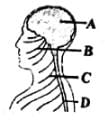Test: Central Neural System (NCERT) - NEET MCQ
15 Questions MCQ Test Biology Class 11 - Test: Central Neural System (NCERT)
In the accompanying diagram of a part of the human body, the structures belonging to the central neural system are labelled as


| 1 Crore+ students have signed up on EduRev. Have you? Download the App |
All sensory information to be registered consciously by the forebrain must pass via the
Which of the following is a part of our brain?
The correct sequence of meninges from inner to outer side is
Which of the following parts of brain constitute the brain stem?
Which of these is not a part of the hindbrain?
Which part of the human brain controls the urge for eating and drinking?
Which of these functions is not controlled by the medulla oblongata?
Direction:

Which labelled part controls the process of breathing?
Direction:

Which of the following functions is performed by the labelled 'C' in the given figure?
Which of the following statements is correct regarding cerebellum?
Match Column-I with column-II and select the correct option from the codes given below.
Column-I
(A) Medulla oblongata
(B) Floor of mid brain
(C) Thalamus
(D) Cerebral hemispheres
(E) Cerebellum
Column-II
(i) Involuntary breathing movements
(ii) Accurate voluntary movements
(iii) Seat of memory
|
182 videos|366 docs|154 tests
|

















